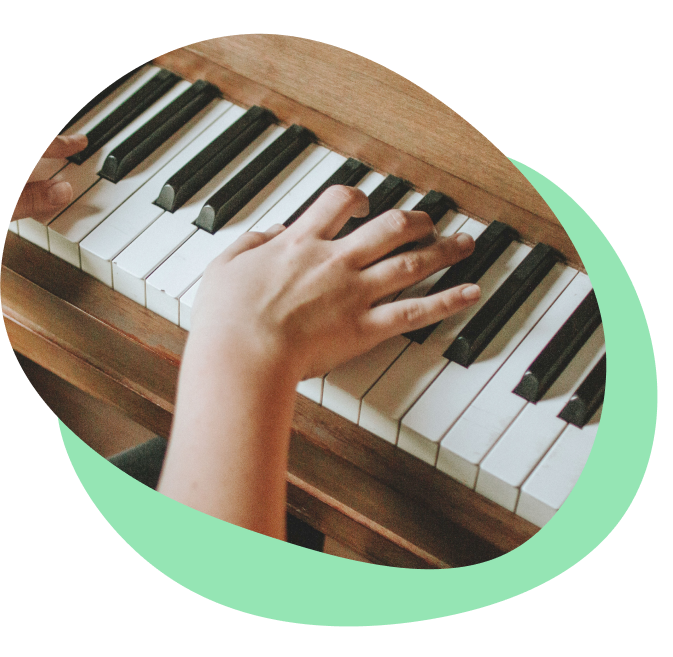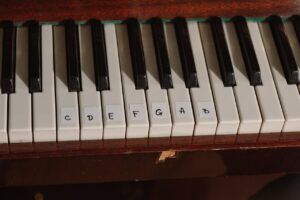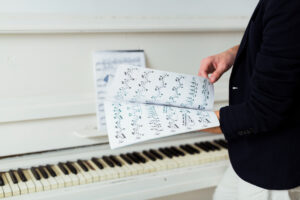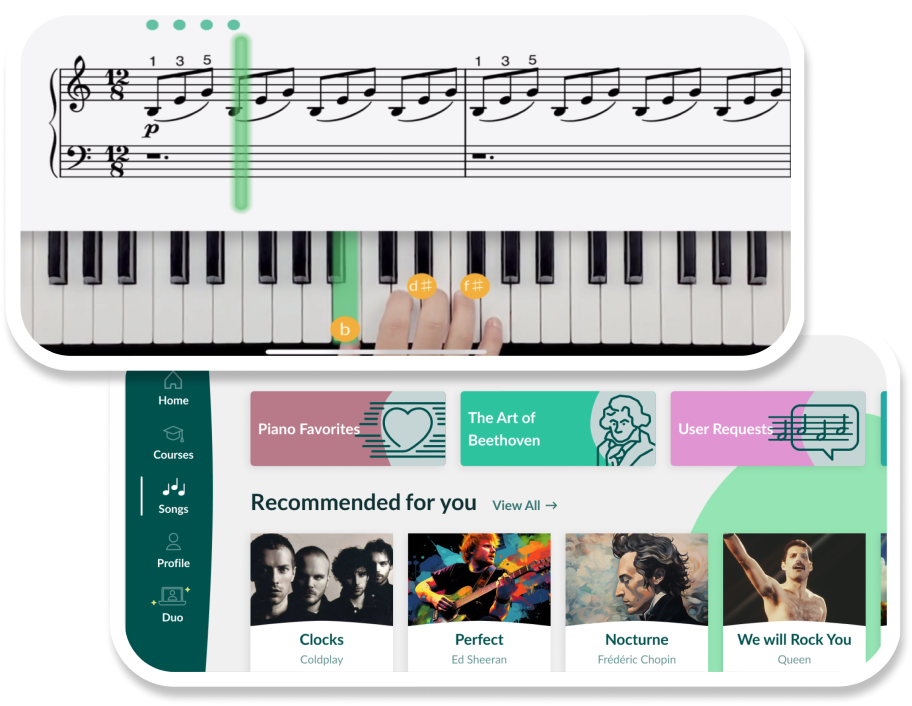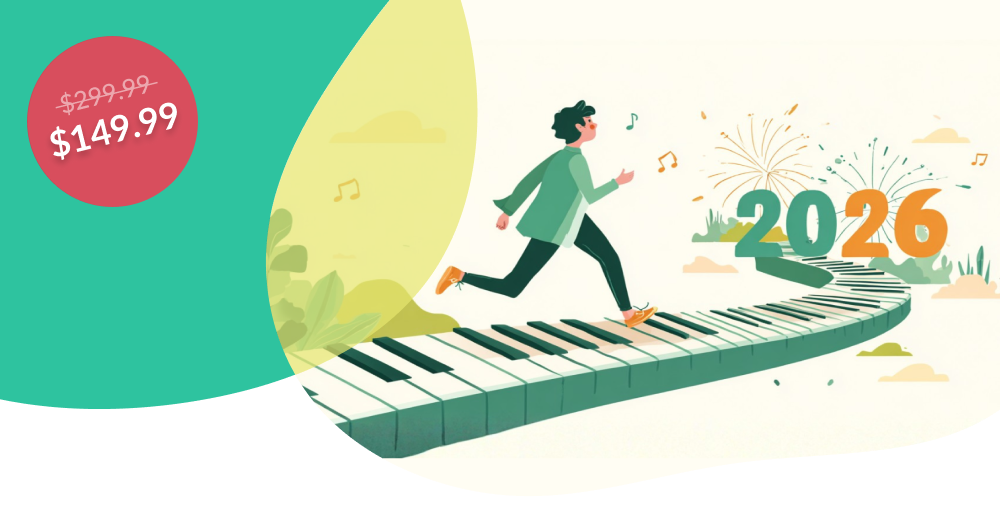The C minor chord (Cm) is C, E-flat, G. You play it by putting your fingers on those notes all at once and voila! You’ve got a sad sounding chord perfect for moody music, Skoove will show you the easiest finger positions to get started.
C minor chords are built from the C minor key signature, which features three flats. Understanding these chords involves learning about Roman numerals in music theory.
C minor chords are featured in well known songs across genres and are commonly played on guitar as well as piano.
We will also take a look at some common chord progression and some great songs that use a C minor triad so you can get playing it in no time, no pressure just music!
Introduction to C minor
The C minor key is a cornerstone of music theory, known for its expressive and evocative sound. At the heart of this minor key lies the C minor chord, a minor triad built from the notes C, Eb, and G. This combination of notes creates a distinctively somber and rich character, making the C minor chord a favorite for conveying emotion in music. Understanding the C minor key means recognizing how the minor triad forms the foundation for countless songs and compositions. Whether you’re playing a single chord or exploring the full range of minor scales, the notes C, Eb, and G are essential building blocks in the world of music. By learning the basics of the C minor key, including its key signature and the structure of its minor scales, you’ll unlock new possibilities for creativity and expression in your playing.
Key of C minor
The key of C minor is defined by its key signature, which features three flats: Eb, Ab, and Bb. This minor key shares its key signature with its relative major, Eb major, making it an important concept in music theory. The relationship between the key of C minor and Eb major allows musicians to move smoothly between major and minor tonalities within the same piece of music. The C minor key is often chosen for its ability to evoke feelings of melancholy, introspection, and drama, making it a popular choice in both classical and contemporary music. Additionally, C minor is closely related to its parallel major, C major, which shares the same tonic note but has a different key signature and a brighter, more uplifting sound. Understanding the key of C minor, its three flats, and its connections to other keys is essential for any musician looking to deepen their knowledge of minor keys and expand their musical vocabulary.
Minor scales
Minor scales are fundamental to understanding the sound and structure of minor chords and minor chord progressions. The C natural minor scale is made up of the notes C, D, Eb, F, G, Ab, and Bb, following a specific sequence of whole and half steps that gives it its unique character. This natural minor scale forms the basis for the c minor chord and many other diatonic chords within the key. In addition to the natural minor, the harmonic minor scale raises the seventh scale degree, resulting in the notes C, D, Eb, F, G, Ab, and B, which adds a distinctive tension and flavor to minor key music. Mastering these minor scales is crucial for creating expressive minor chord progressions and understanding how different chords fit together within the c minor key. The C minor scale also shares its key signature with its relative major, Eb major, allowing for smooth transitions between major and minor sounds in your music. By exploring the patterns and intervals of minor scales, you’ll gain a deeper appreciation for the emotional depth and versatility of minor keys.
How to identify the C minor chord on piano
To identify a C minor chord on the piano, you first need to find the root note. This is the bottom note of the chord (so, in this instance, C). The C minor chord has three notes in it. The interval between C and Eb is called a minor third, which is a key component of the chord’s structure. Pay particular attention to the Eb key, which is one of the black notes on a piano and is of course what makes the C minor chord sound different from a C major chord. Be aware of how your hand sits differently when playing the C minor chord, as the middle Eb key is elevated just above the white keys. Eventually you will get used to this just by feeling where the notes are, much in the same way as you can type on a computer keyboard without needing to look at your fingers. Be careful not to overly rely on your eyesight when learning and always remind yourself of the correct hand and sitting position. This will improve your playing when you are looking at sheet music, playing on stage, or communicating with other musicians if playing in a band or orchestra. It is really important to learn how to play the piano by feel, with your hands, instead of only using your eyesight.
The C minor chord can also be played on the guitar fretboard, using different finger positions and chord shapes.
How to play the C minor chord in root position?
To play the C minor triad you need three notes: C, Eb, and G. To start find B, the white key just before the two black keys. Then add Eb (a black key), which is the third scale degree in the C minor scale, and G.
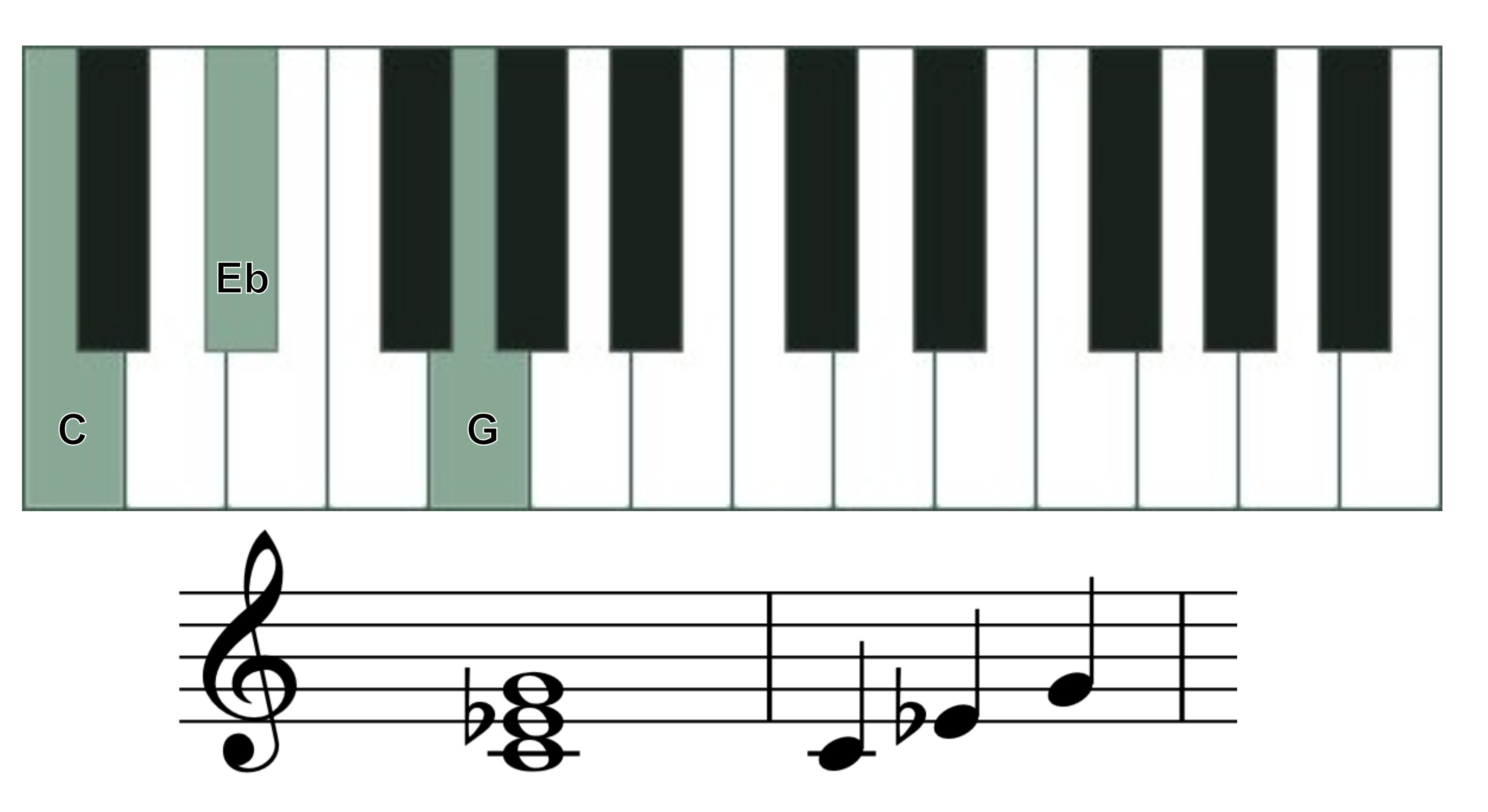
The C minor chord consists of three notes C, Eb and G.
These notes are called: the root (C), third (Eb), and fifth (G). Together, they create a rich and deep sound. The C minor chord serves as the tonic chord in the key of C minor.
To play this chord in its root position (basic form) with your right hand, use these fingers:
- G – Fifth finger (5)
- Eb – Third finger (3)
- C – Thumb (1)
For the left hand, use the following fingers:
- G – Thumb (1)
- Eb – Third finger (3)
- C – Fifth finger (5)
What are the inversions of the C minor chord?
The inversions of a chord are made by changing the order the notes are played. Chord inversions let you control how you emphasize each note of the chord.
How to play C minor first inversion?
To play the first inversion of the C minor triad, start with Eb as the first note. Add G above it and finally add C as the high note. This mix up gives Cmin a fresh sound that’s new and great for spicing up chord sequences.
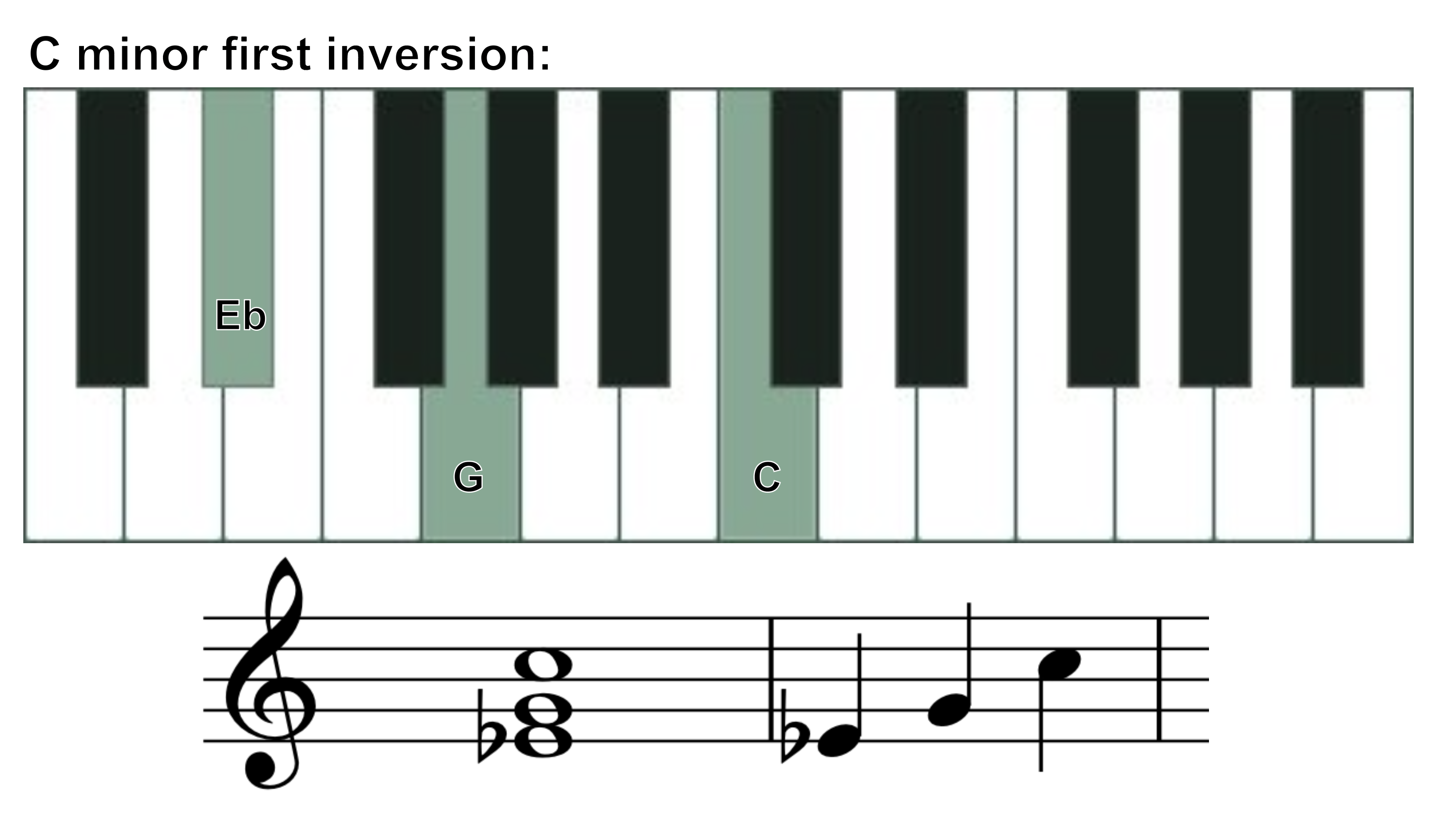
For the right hand, use these fingers:
- C –Fifth finger (5)
- G –Middle finger (3)
- Eb –Thumb (1)
For the left hand, use these fingers:
- C – Thumb (1)
- G – Third finger (3)
- Eb – Fifth finger (5)
How to play C minor second inversion?
For the second inversion of the Cm piano chord, have G as the lowest note. Then play C above it and finally put Eb as the highest note. This gives the chord a different sound and is often used to make chord transitions and choices more interesting.
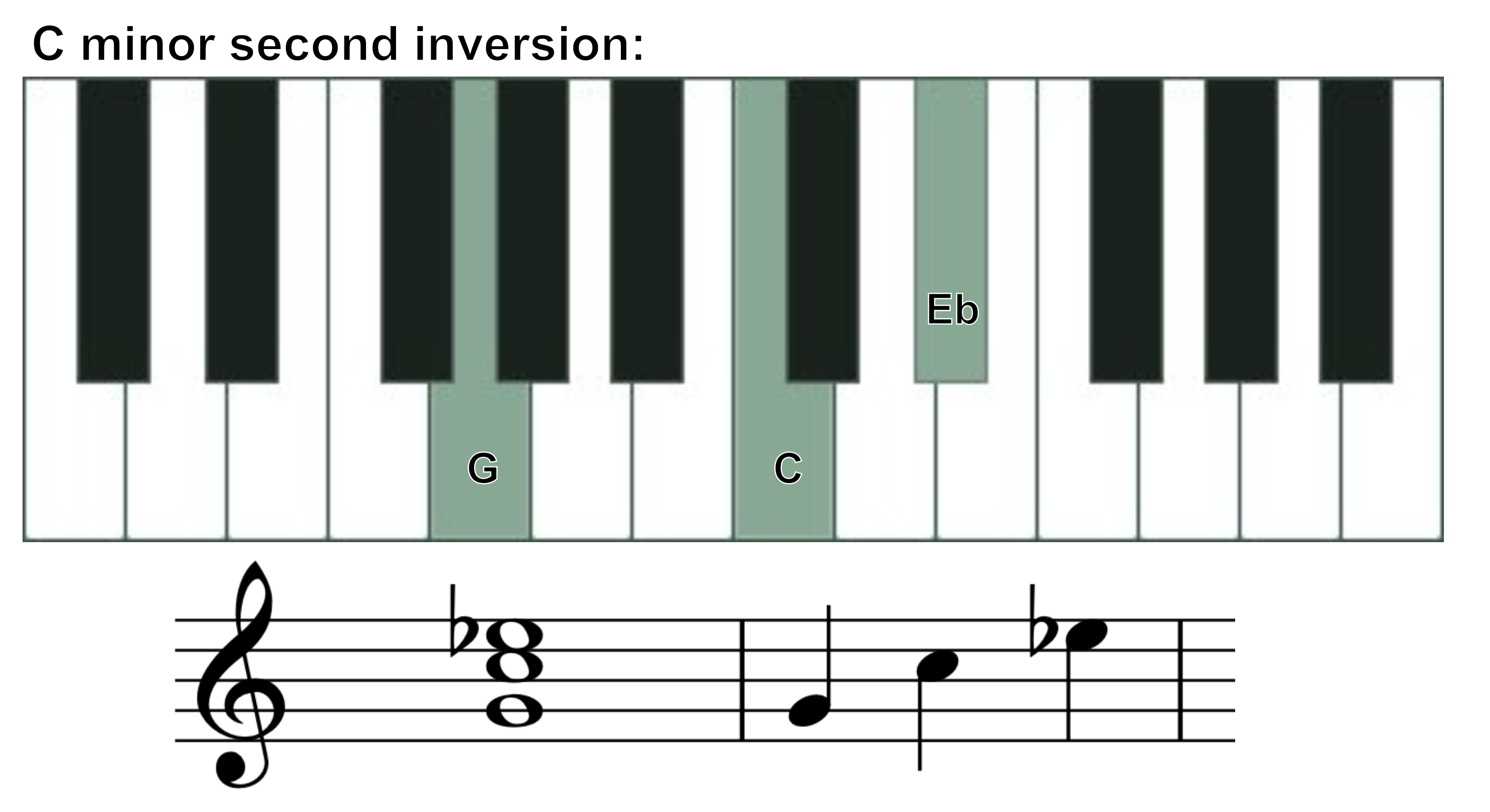
For the right hand, use these fingers:
- Eb – Fifth finger (5)
- C – Middle finger (3)
- G – Thumb (1)
For the left hand, use these fingers:
- Eb – Thumb (1)
- C – Second finger (2)
- G – Fifth finger (5)
Common chord progression in the key of C minor
C minor chord progressions are used in lots of genres, from rock and pop to jazz and classical music. A Cm chord progression often includes chords like Cm, G, Fm and Ab. Here are some popular C minor chord progressions to get you started:
- Cm – G – Ab – G / I – V – VI – V
- Cm – G – Fm – G / I – V – iv – V
- Cm – Ab – Fm – G / I – VI – iv – V
- Cm – F – Ab – G / I – iv – VI – V
In the key of C minor, all the chords built from the scale tones are called diatonic chords. These are: i (C minor), ii° (D diminished), III (Eb major), iv (F minor), v (G minor, or G major in harmonic minor), VI (Ab major), and VII (Bb major). The ii chord (D diminished) acts as a supertonic and often leads to the dominant or tonic. The iii chord (Eb major) is the mediant, providing a brighter contrast and connecting the subdominant and dominant chords. The iv chord (F minor) is the minor subdominant, adding emotional depth and a somber mood. The v chord (G minor, or G major in harmonic minor) serves as the dominant, creating tension that resolves to the tonic. The vi chord (Ab major) is the submediant, offering stability and contrast. The vii chord can be the subtonic (Bb major) in natural minor or the leading tone diminished triad (B diminished) in harmonic minor, helping with smooth voice leading and modulation.
These common chord progressions use various combinations of these diatonic chords, and the final chord in a progression is often the tonic chord (Cm), providing a sense of resolution and musical closure.
These sequences are a great way to put your new understanding of piano chords into practice. To understand these chord symbols and how to play them, have a look at our tailor-made beginner chord progression courses.
C minor triad: what is the difference between a triad and a chord?
Did you know that all triads are chords, but not all chords are triads? A triad is basically a chord that has only three notes, and these notes must be built in thirds. In this instance, therefore, a C minor triad is exactly the same as a C minor chord. If we start adding other notes to the C minor triad – for instance if we added an extra C at the top, this would no longer be a triad as we now have four notes. Or if we added a B flat to the C minor triad, it would be called a C minor seventh chord and again would no longer be classed as a triad. Chords like the C minor 7th are very commonly used as jazz chords on the piano.

Piano chords generator
💡 If you are reading this from a mobile device, rotate it to display the tool in full width.
1. Click on “Chords”
2. Choose the “Root” of the chord
3. Choose the “Chord qualities” (major, minor, etc.)
4. Click “Display”
Author of this blog post:
Matthew Dickman

With over a decade of experience in music education Matthew holds a BA in Music from Paul McCartney’s LIPA and an MA in Composition from the University of Salford. Mathew has developed a distinctive compositional voice and approach to music theory education through his research and work in the music industry. Matthew’s writing for Skoove combines experience from orchestral and media composition, and as a gigging jazz musician, to create a wholistic and accessible pedagogy for musicians of any level. Away from music, he enjoys reading and exploring nature to expand his horizons and knowledge contributing to his holistic teaching style.




